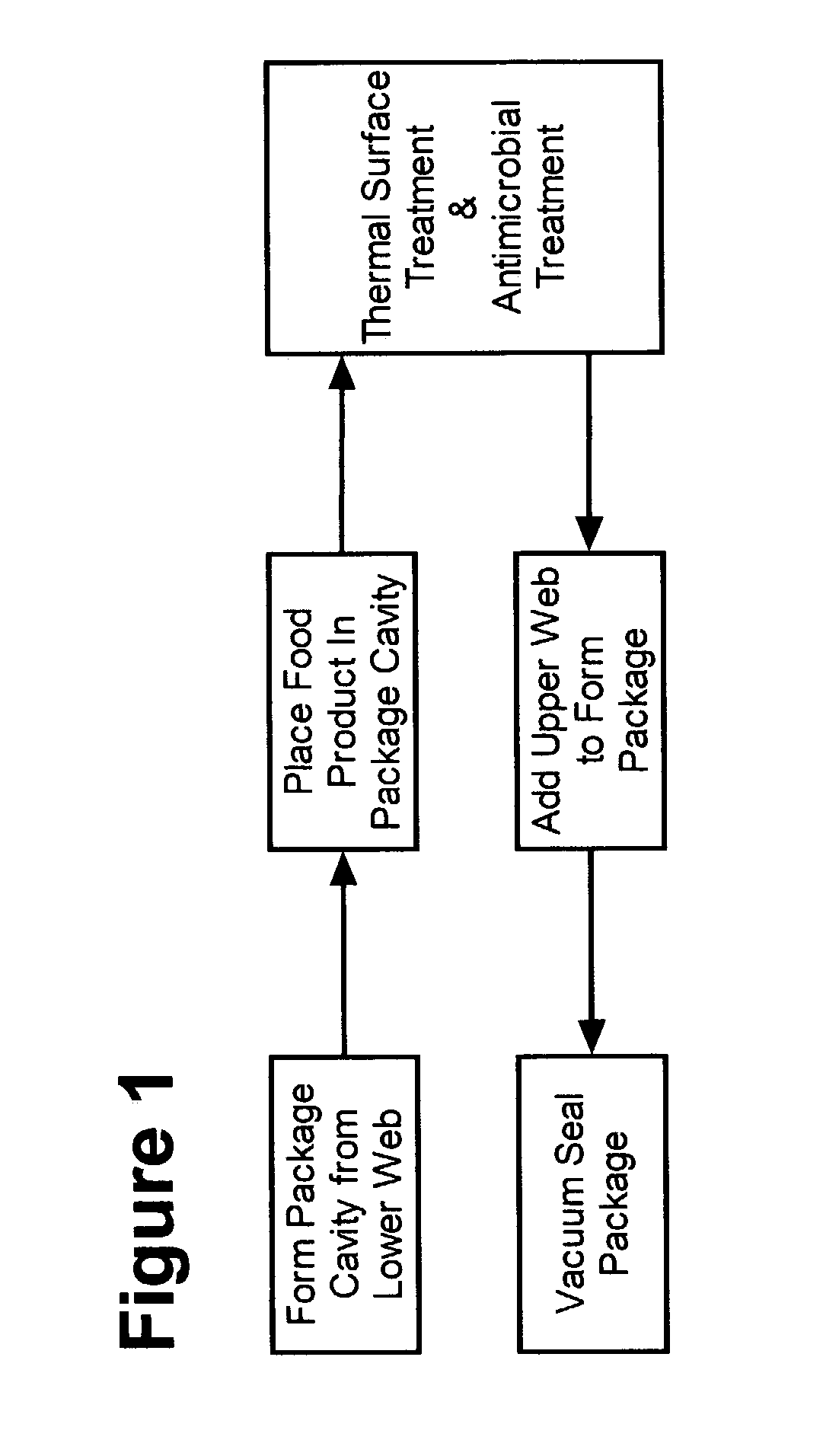Method for controlling microbial contamination of a vacuum-sealed food product
a vacuum seal and food product technology, applied in the direction of preventing decay, meat/fish preservation by coating, packaging foodstuffs, etc., can solve the problems of inability to inspect each package of food, incomplete or otherwise insufficient application, and reduce the antimicrobial effect of the produ
- Summary
- Abstract
- Description
- Claims
- Application Information
AI Technical Summary
Benefits of technology
Problems solved by technology
Method used
Image
Examples
example 1
[0090]This example provides the general procedure for vacuum sealing wieners for controlling contamination of a vacuum-sealed product. Surface dried wieners (a total of ten weight 1 lb) were packaged with 3.0 grams / lb of water (control samples) or an antimicrobial solution applied at the bottom of the package using the following method. The wieners were placed on top of a bottom section of a two-part continuously extruded plastic sheet for vacuum-sealing. After the wieners were placed on the bottom section, the water or antimicrobial agent (as indicated in the following examples) were applied. The top section was then placed on top of the wieners and a vacuum sealer was used to seal the bottom and top sections together. The vacuum seal was performed using a commercial vacuum sealer at a vacuum pressure of about 26 inches Hg. When the packages were later opened, wet and shiny surfaces were observed indicating complete coverage over the exterior surfaces.
example 2
[0091]This example uses a surface rewetting test to analyze the ability of the liquid application method described in Example 1 to effectively coat or cover the surface of packaged wieners. Surface dried wieners were packaged with water as described in Example 1. Small squares (about 1 mm×1 mm) of “Post-it” paper were applied to wieners at various locations along the top, middle, and bottom of the package. Different physical sublocations within each package were tested including the front and back of links, between links, and against the top or bottom section of the film. Most of the test squares became wetted during the sealing process; all test squares became wetted within 15 minutes after the sealing process was complete. Adding more liquid resulted in faster and, in some cases, immediate wetting. Thus, the method described in Example 1 resulted in complete liquid distribution on the surface of the wieners after packaging.
example 3
[0092]This example utilizes a chemical distribution test to analyze the ability of the method described in Example 1 to effectively coat the surface of packaged wieners with an antimicrobial solution. Ten surface dried wieners were repackaged with 3.0 grams of an aqueous antimicrobial solution that included bacteriocins (i.e., nisin and / or pediocin) as the active antimicrobial agent applied at the bottom of the package as described in Example 1. Chemical distribution of the active antimicrobial agent was confirmed using Listeria lawn clearance analysis (wiener skin samples were placed on a Listeria lawn; a clearance zone growing around the sample indicated antimicrobial agent coverage). For this analysis, wieners were stored for 24 hours at about 34° F. after completion of the vacuum-sealing process. Then the wieners were skinned and chemical distribution of the antimicrobial agent using the Listeria lawn clearance technique was measured for 15 samples / package wherein the samples we...
PUM
 Login to View More
Login to View More Abstract
Description
Claims
Application Information
 Login to View More
Login to View More - R&D
- Intellectual Property
- Life Sciences
- Materials
- Tech Scout
- Unparalleled Data Quality
- Higher Quality Content
- 60% Fewer Hallucinations
Browse by: Latest US Patents, China's latest patents, Technical Efficacy Thesaurus, Application Domain, Technology Topic, Popular Technical Reports.
© 2025 PatSnap. All rights reserved.Legal|Privacy policy|Modern Slavery Act Transparency Statement|Sitemap|About US| Contact US: help@patsnap.com



